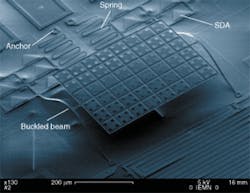At the Northern Higher Institute of Electronics (ISEN; Villeneuve d'Ascq, France), researchers have developed a way of producing fixed arrays of three-dimensional (3-D) micromirrors with only a simple electrical actuation step to raise the devices out of plane. Their technique uses a self-locking mechanism that keeps the mirror supports in position even when the actuators that control them are switched off. The resulting devices are free to rotate by as much as 15° in either direction and have been run continuously at resonance for 72 h without signs of wear. The researchers say that the self-assembly principle they used should be of general use in building 3-D structures from planar processes.
The fabrication methods used by the ISEN team are based on conventional polysilicon surface micromachining using a sacrificial oxide. The structure created using this technique consists of a mirror that is entirely free except for thin protrusions on centered opposite sides. Each of these is perpendicularly connected to a beam that can be pushed by a scratch drive actuator (SDA) at one end, and is fixed at the other.
The SDA is a 90°-clockwise-rotated structure that is L-shaped from the side and triangular from the top (see Fig. 1). When the long part of the L (wide part of the triangle) is electrostatically sucked down toward the surface of the chip, the part near the corner is forced to bend outward. This action pushes out the short part of the L, which makes high-friction contact with the substrate. When the downward force is released, the restoring force from the bent structure pulls the whole thing forward.
The device is anchored in place by tiny springs that would pull the device back to its starting point once the drive power was switched off. However, the central beam includes a T-shaped section which, on actuation, is pushed down and forward underneath two fixed structures that overhang the outer beams of the T: it has been specially thinned to make this possible. When the drive is released, the unbending of the SDAs changes the relative height of T so it cannot clear the overhangs. Thus, the structure is caught—latched—despite the fact that the spring is pulling it back.
During self-assembly, the scratch drives are used to push the mirror-holding beams forward. Because they are fixed at the other end, they buckle to form an arch, thus raising the mirror from the plane of the substrate (see Fig. 2). The latch mechanism ensures that they remain in this position for the life of the device. The mirror can then be actuated using opposing electrodes. These are buried in the same footprint as the mirror itself, one on either side of its rotational axis.It turns out that the thin beams supported by the self-locking mechanism also have a role in reducing the voltage required to drive the mirrors. Researchers first modeled the device by considering that the mirror deflection could only take place with the corresponding torsion or twist in the axis-of-rotation protrusions—in this case, 15°. To accomplish this action would have required 3600 V. However, by considering the flexion of the supporting beams as well, moving the mirror theoretically requires just 218 V, very close to the experimental value of 208 V.
The French researchers are already considering ways of improving the self-assembly technique for other applications, and suggest that the simplicity and reliability of their mechanical latch should make microelectromechanical systems (MEMS) and optical MEMS a much cheaper prospect in the future.
REFERENCE
- E. Quévy et al., IEEE Trans. on Elect. Dev. 48 (8), 1833 (August 2001).

